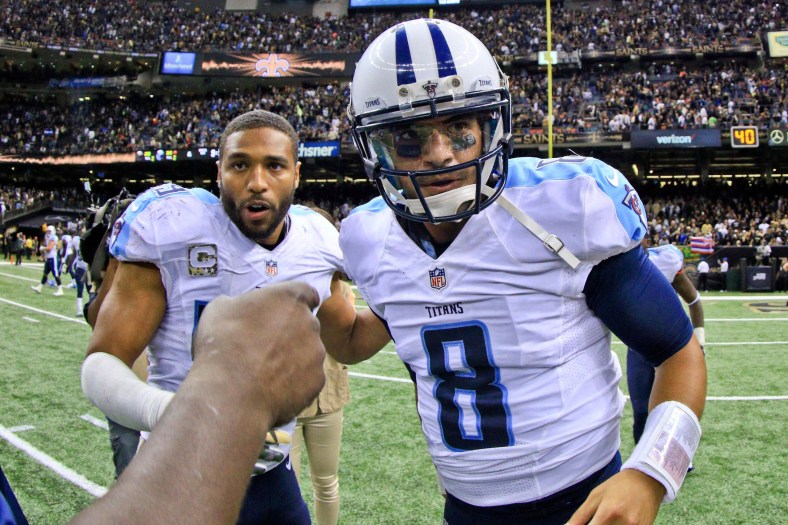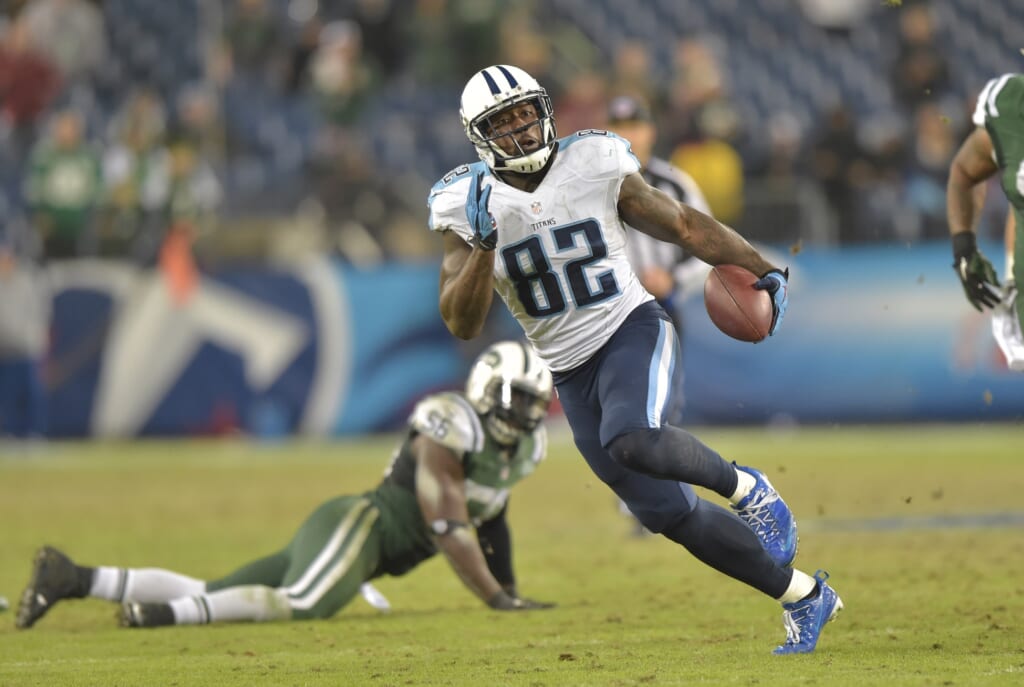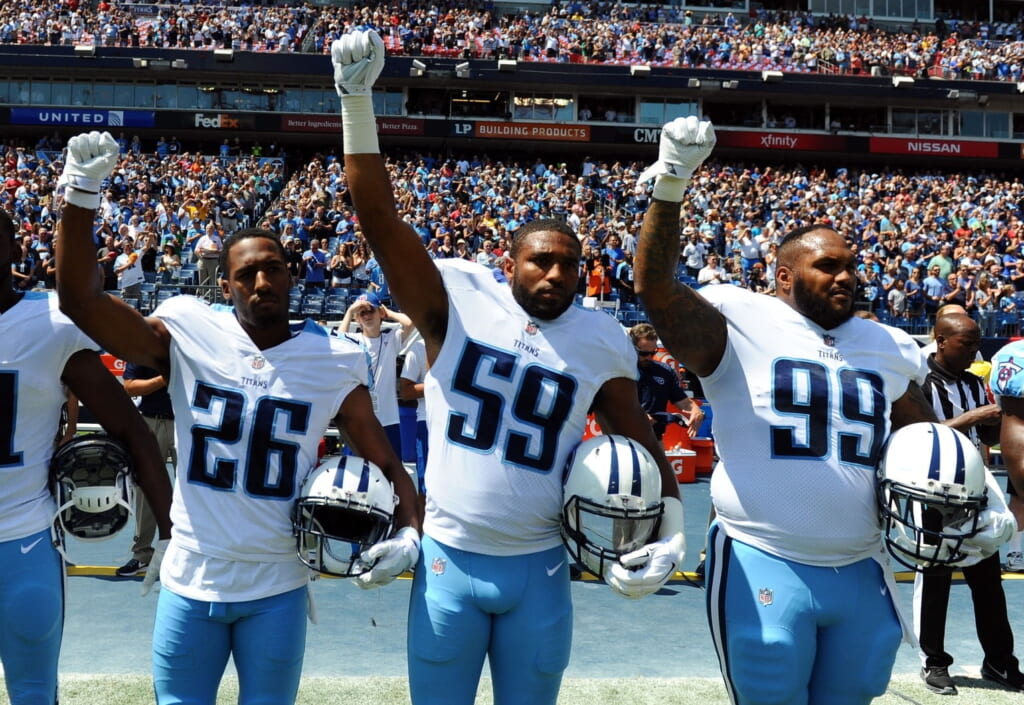
The Tennessee Titans are ready to jump into contention.
This is Year 3 for quarterback Marcus Mariota, and we’ve seen him grow into one of the league’s stars. In 2016, Mariota ranked tenth among quarterbacks in DVOA, throwing for 26 touchdowns and just nine interceptions. He rarely made a bad decision and displayed great accuracy when throwing everywhere but deep. It’s worth noting that he did this without much of a receiving corps and in a scheme that didn’t help him much. Tennessee’s scheme probably won’t change much with Mike Mularkey as the head coach, but the Titans did beef up at wide receiver this offseason. It should be a prelude to a breakout season for Mariota.
The biggest acquisition made by Tennessee at receiver was Corey Davis, whom it took with the fifth overall pick in the draft. Whether the pick should have been spent on Mike Williams instead is a conversation worth having, however, Davis is going to be a very good receiver on his own merits. The Western Michigan product is a precise route runner who can rack up yardage after the catch. He’s a big body and can make tough plays. However, his physicality needs some improving, especially given that Davis isn’t the type of player who can separate with speed. There were also some drop issues last year — Davis had 11 of them, per PFF. Overall, he should be able to contribute immediately in Tennessee. Having spent such a high pick on him, the Titans obviously see Davis as Mariota’s top target for a long time. Expect him to slide into that role relatively soon.
The Titans also added Eric Decker this offseason, via free agency. Decker is 30 years old and coming off an injury. But if healthy, he adds a reliable veteran presence to Tennessee’s lineup. In 2015, when he was healthy, Decker went for 1,027 yards and had a 60 percent catch rate with the Jets.
Rishard Matthews quietly put up a strong 2016, going for 945 yards on 65 receptions. He also ranked 15th among receivers in both DYAR and DVOA. Additionally, third round pick Taywan Taylor will get some playing time. Taylor has the speed to be a capable deep threat and averaged 17.7 yards per reception at Western Kentucky last year.
At tight end, Delanie Walker is one of the league’s best downfield threats. He had 800 yards last year and it’s hard to see him slowing down despite being 33 years old. This receiving corps went from thin to deep over the offseason and should be the complement to a great rushing attack.

Tennessee ranked eighth in rushing DVOA last season, thanks in large part to the offensive line. At the tackle positions, Taylor Lewan and Jack Conklin were two young studs. Lewan had an All-Pro-caliber 2016, putting up an 87.7 PFF grade. Conklin was slightly better by that metric with an 88.6 mark, however, he was helped out by the Titans’ scheme. That shouldn’t, however, diminish the fact that he’s 23 years old and coming off a rookie year in which he blew just seven blocks, per Football Outsiders’ Almanac. On the interior, not one starter blew more than 10 blocks last year, per FOA. Center Ben Jones ranked eighth at his position in PFF grading with an 83.0 mark. Left guard Quinton Spain enjoyed a career year in which he blew just one pass block, per FOA, and right guard Josh Kline had a 79.3 PFF grade. In addition to ranking fifth in adjusted line yards, Tennessee was also fourth in pressure rate last season, per FOA.
As good as the line was, the Titans had some talent at running back as well. DeMarco Murray shattered expectations by rushing for 1,287 yards with a 50 percent success rate last season. However, he may not be long for the starting job. Derrick Henry averaged 4.5 yards per attempt in his rookie season and could be ready to move into the starting position. Even if he does, however, expect both backs to get a decent share of work. Both are talented enough to warrant it and both will do well behind this line.
Defense was where Tennessee cost itself the AFC South last year, as it ranked 24th in DVOA. However, the organization took steps to improve, starting with the secondary. The Titans spent the 18th overall pick in the draft on Adoree’ Jackson, a cornerback out of USC. Jackson displayed good ability in man, zone, and off coverage at school, though he was inconsistent when the Trojans pressed. He can run routes with the receiver and was a better tackler than most corners coming out of college. Size is the biggest hitch in his game — at 5-foot-10 he may struggle with bigger receivers. The Titans may play him in the slot to help mitigate that. Expect to see opposing teams test him with shorter routes early in the year as well, as he sometimes struggled to defend them at USC.
The Titans also spent big money to bring in cornerback Logan Ryan during free agency. Ryan gives them a strong outside corner, which they had been lacking. His 83.1 PFF grade last season ranked 17th at the position, and Ryan put up good run defense numbers as well. His 58 percent run stop rate was 13th among corners last year, per FOA. Across from him, Brice McCain ranked ninth at the position with a 57 percent success rate, per FOA, while giving up just 7.0 adjusted yards per target.

At safety, Tennessee also spent money to bring in Johnathan Cyprien, who ranked seventh at the position with an 88.9 PFF grade last season. Much of that was due to run defense, as Cyprien had a 60 percent run stop rate, per FOA, and an absurd 97.5 run defense grade from PFF. Cyprien is decent in coverage as well, ranking 34th among safeties in adjusted yards per target, according to FOA. Run defense was clearly something the Titans wanted to emphasize in the secondary. Next to Cyprien, Kevin Byard led all safeties with a 68 percent run stop rate, per FOA. Da’Norris Searcy, who will see time as a substitute, ranked 16th among safeties in the stat, per FOA. Byard also had good numbers in coverage, ranking second among safeties with just 5.4 adjusted yards per target, according to FOA.
The front seven is largely the same as last year, however, that’s far from a bad thing. Tennessee’s defense led the league last year in power success and ranked 12th in adjusted line yards. Pressure may become an issue, as the Titans often had to blitz in order to get to the quarterback in 2016, but this is still a solid group. Defensive end Jurrell Casey will anchor the defensive line in the Titans’ 3-4. Casey is the line’s biggest pass-rushing threat, putting up 5.0 sacks, 16 hits and 23 hurries, per FOA. He also finished tenth among interior defenders with an 87.1 PFF grade. Next to him on the inside, nose tackle Sylvester Williams is the only new face in the front seven. Williams has pedigree from Denver’s 2015 Super Bowl champion team. However, he struggled for most of last season. Williams had just a 60 percent run stop rate, ranking 84th at his position, and an abysmal 50.4 PFF grade. Karl Klug could get snaps on the interior as well, assuming his Achilles is healed (pun intended) by Week 1. DaQuan Jones should start at the end opposite Casey. Jones had a 79.4 PFF grade last season, though he isn’t an impactful pass rusher, with just 1.5 sacks, four hurries and 12 hits, per FOA. However, he did have a 77 percent run stop rate, also per FOA.
The Titans should be well-equipped on the edge with the duo of Derrick Morgan and Brian Orakpo at outside linebacker. Morgan was probably the team’s best all-around defender last season. He had 9.0 sacks, 12 hits and 33 hurries while ranking fourth among edge rushers with an 88 percent run stop rate, per FOA. As for Orakpo, he put up 10.5 sacks, eight hits and 29 hurries of his own, per FOA. He also had an 80.3 PFF grade despite not being much of a run defender. On the inside, Avery Williamson and Wesley Woodyard leave something to be desired. Both had success rates below 40 percent in coverage last year, per FOA. While the pair was solid in run defense, their coverage problems showed up in the numbers. Tennessee had a 13.7 percent DVOA against short passes to the middle of the field last season, well below the league average of 8.2 percent (for those not well-versed in DVOA, lower numbers are better on defense). Losing Sean Spence to the Colts will hurt them in this area even more. Fifth-round pick Jayon Brown and seventh rounder Josh Carraway will get rotational snaps at inside and outside linebacker. However, the starting jobs are unlikely to change hands without injury.
Whether the Titans are a Super Bowl contender is very much in doubt. That depends a lot on Mularkey, injury luck and how the rest of the AFC shakes out. However, Tennessee should be aiming for a first-round bye. With an AFC South schedule, they have a leg up on every team in the conference other than New England. Moreover, the AFC West could cannibalize itself when it comes to playoff seeding.
If the Titans don’t at least win the division, this year is a failure.
If you would like to learn more about the advanced stats we used, check out FootballOutsiders.com, which is largely free, or ProFootballFocus.com which is not.